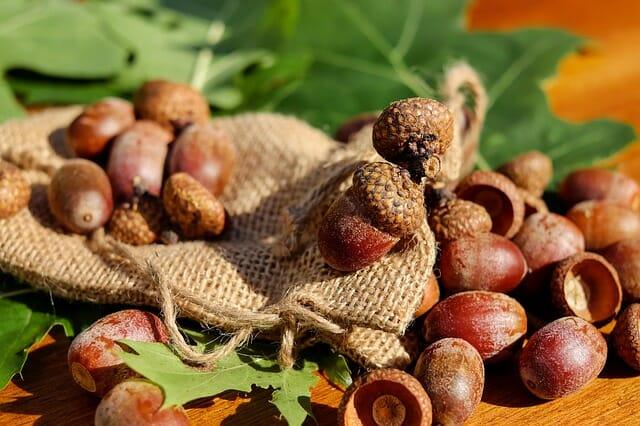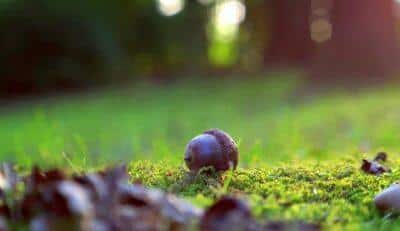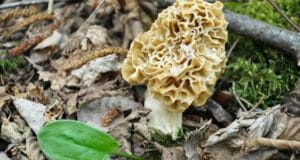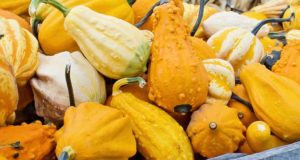A variety of oak trees across North America produce acorns that usually mature in early to late fall. The size and shapes vary — and so does the flavor. There are basically two types of acorns: bitter and sweet. What makes an acorn bitter is a chemical referred to as tannins, or tannic acid. Certain oaks, like red oaks, have the highest amounts of tannins, while burr oaks and white oaks have less.
Any acorn should be processed to leach out tannins, regardless of whether they are bitter or sweet. The fundamental process involves either a boiling water bath or cold-water bath to remove the tannic acid. This process can take a couple of days up to a week or more, depending on the amount of tannins in the acorns.
The Hot-Water Bath
To leach the tannins out of acorns quickly, the acorns are immersed in gently boiling water. Only brown mature acorns should be used. Green acorns won’t work, and have on off-taste. The mature acorns are typically found on the ground, while those still on the tree tend to be green. The caps are removed from the acorn and a slit is cut in the side of the acorn. Sometimes you can peel the skin off the acorn after cutting this slit, but usually they need to be boiled for a while before the skin can be easily removed.
Finally, A Backup Generator That Doesn’t Require Gasoline!
To determine when the acorns have been sufficiently soaked, a simple taste will do. If it tastes bitter, then continue the slow boil and change the water every couple of hours. You’re trying to get rid of the tannins and without this water change you’ll simply reintroduce the tannins into the acorns.
The Cold-Water Bath
Some people feel that the hot-water leaching process removes much of the flavor from the acorn. The alternative is a cold-water soak, but this will take much longer. The acorns are again prepared by removing the caps from the mature acorns and cutting the slits. The acorns are then soaked for days at a time with water changes occurring at least daily if not twice a day. Here again, a quick taste of the acorn will tell you when they have been sufficiently soaked.
Drying the Acorns
After any type of soaking, the acorns need to be dried. This can be done by putting them on a tray in the sun or gently roasting them in the oven at 225 degrees Fahrenheit. Once again, a taste test will tell you when the acorns are sufficiently dry.
Storing Acorns
The best way to store acorns after they are dried is in a canning jar in the refrigerator or a root cellar. The shelf life will vary from a week to months, depending on how well they have been dried and the variety. Keep an eye on them if you have stored them and if you see any sign of mold or notice a mildew smell, discard them.
Roasting Acorns
To roast acorns, I’ll usually give them a quick rinse in cold water and then roll them around in some salt. Place them on a baking sheet and roast at 350 degrees for one hour. Taste them after an hour until they suit your taste and have the texture you want.
Chopped Acorns
Chopped acorns can be used as a topping on desserts, incorporated into baked goods or tossed onto a salad for some added crunch. They can either be chopped on a cutting board with a knife or in a food processor. The size of the chop is up to you.
Acorn Butter
To make acorn butter, continue to chop until the acorns begin to develop a smooth consistency. This can take a while depending on the acorn variety and the amount of oil in the acorns. You can easily combine different varieties to make an acorn butter blend.
Acorn Flour
The best way to make acorn flour is to chop them fine and then run them through a flour mill. You could also try to use a food processor, but the acorns will need to be very dry or you’ll end up with another batch of acorn butter. If you want to make sure the acorns are extra dry, take the chopped acorns and roast them on a baking sheet in the oven at 225 degrees for a couple of hours. Toss them from time to time on the baking sheet to expose as much of the surface area to the heat. You could also put them on a paper towel in a food dehydrator to dry them out for flour making.
To bake with acorn flour, use it the same way you would use conventional flour but the addition of some regular flours like all-purpose flour or bread flour will help with the consistency and rise.
Competing With the Squirrels
When harvesting acorns, look for the acorns that have no split in the outer shell or any sign of insect damage. It’s okay if the caps have fallen off, but avoid the ones with splits in the shell or green ones. You’ll also have some competition from squirrels when it comes to finding acorns on the ground. Squirrels love acorns, but they also prefer the relative safety of a nearby tree. If you see an oak standing out in a field un-surrounded by other trees, your odds of beating the squirrels will improve. Typically, a squirrel won’t travel farther then 30 yards from the nearest tree. An isolated tree is less likely to have any visits from squirrels and the acorns will be plentiful.
How do you prepare and eat acorns? Share your tips in the section below:
 Off The Grid News Better Ideas For Off The Grid Living
Off The Grid News Better Ideas For Off The Grid Living





